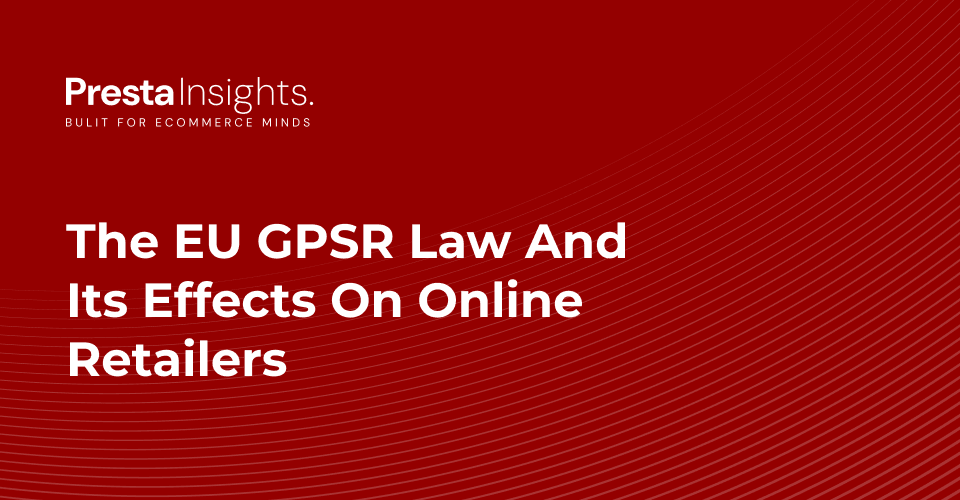The General Product Safety Regulation (GPSR) is one of the most significant legal updates in the European Union’s product safety landscape. As a PrestaShop store owner, online retailer, or global dropshipper, it’s essential to understand the implications of this law and how to prepare for its enforcement starting December 13, 2024.
What is the EU GPSR Law?
The General Product Safety Regulation (EU) 2023/988 replaces the older General Product Safety Directive (GPSD) 2001/95/EC. Unlike the directive, which had to be implemented into national law by each member state, the GPSR is a binding regulation—it applies directly in all EU countries without additional legislation.
Its primary aim is to ensure that all consumer products sold in the EU market—whether through traditional retail or online platforms—are safe and traceable. This includes goods imported from non-EU countries via online channels.
Why Does It Matter for eCommerce Businesses?
The EU GPSR affects a wide range of sellers:
- Independent PrestaShop store owners
- Shopify, WooCommerce, and Magento sellers
- Amazon, Etsy, eBay, and other marketplace vendors
- Dropshippers sourcing from AliExpress or similar suppliers
If you sell consumer products to EU customers—regardless of your location—you are .
Core Requirements Under the GPSR
Here’s a breakdown of the most important rules that merchants must follow:
1. A “Responsible Person” in the EU
Every product sold in the EU must have an appointed responsible person who is established in the EU. This person is accountable for ensuring product safety, keeping technical documentation, and cooperating with authorities in case of an issue.
For non-EU sellers, this typically means partnering with a third-party representative or fulfillment center located in the EU.
2. Mandatory Seller Information
eCommerce websites must provide:
- Legal name of the seller or business
- Full postal address in the EU
- Contact email and telephone number
This information must be clearly visible before checkout to promote transparency and traceability.
3. Traceability Measures
All products must carry traceable information, including:
- Product identifiers (model, batch, serial number)
- Origin details (country of manufacture)
- Product safety warnings and instructions in the language of the destination country
4. Rapid Product Recalls
Merchants must be capable of quickly removing unsafe products from listings and notifying customers who purchased them. This includes:
- Issuing a recall email
- Publishing notices on the website
- Notifying relevant EU market surveillance authorities
5. Mandatory Incident Reporting
Serious product risks must be reported via the Safety Gate Portal within two business days.
How the GPSR Affects PrestaShop Stores
For PrestaShop merchants, this means making both technical and operational changes:
- Ensure your product pages display seller and responsible person information.
- Add modules or custom code to show batch numbers, origin details, and product warnings.
- Use EU-based logistics partners that can act as responsible entities for your products.
- Set up workflows for fast product takedowns, email notifications, and refunds during recalls.
GPSR for Dropshippers & Non-EU Sellers
The law applies equally to dropshipping businesses. If you import products directly to EU customers via suppliers (like AliExpress or Print-on-Demand), you must ensure those products:
- Have safety documentation
- Include correct labeling and traceability info
- Have an EU-based representative listed
Non-compliance can lead to penalties, takedowns by marketplaces, or blocked shipments by EU customs.
How Marketplaces Are Enforcing GPSR
Marketplaces like Amazon, eBay, and Etsy are implementing stricter onboarding rules, asking sellers to upload compliance documents and provide responsible person details. Failing to provide this can result in your products being suspended or removed.
Practical Steps for GPSR Compliance
- Conduct a product audit – Review every item in your catalog for compliance gaps.
- Update product pages – Add seller info, traceability data, and safety labels.
- Designate a responsible person – Find a trusted EU partner or use a third-party service.
- Train your team – Ensure your staff knows how to handle complaints, recalls, and reports.
- Install compliance modules – Use PrestaShop modules for product labeling, risk reports, or customer communication templates.
Penalties for Non-Compliance
The GPSR introduces stronger enforcement and fines. EU authorities can:
- Ban your product from the EU market
- Issue fines and penalties
- Enforce product recalls at your cost
- Publicly list your company on alert registries
Conclusion: GPSR is Not Optional
The General Product Safety Regulation is reshaping the future of online retail in Europe. While it imposes stricter rules, it also provides an opportunity to build stronger customer trust and future-proof your business.
By acting now, PrestaShop store owners and other merchants can avoid disruptions and stay ahead of competitors who are slow to adapt.
💡 Need help? Stay tuned to PrestaInsights for tutorials, module reviews, and compliance checklists to help you implement GPSR smoothly on your PrestaShop store.



